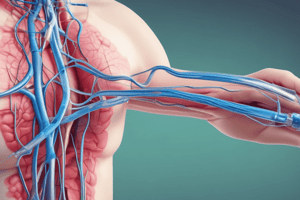Podcast
Questions and Answers
What is the most common cause of infection after childbirth?
What is the most common cause of infection after childbirth?
- Escherichia coli (correct)
- Streptococcus pneumoniae
- Klebsiella pneumoniae
- Staphylococcus aureus
Which of the following is NOT a danger sign of infection after childbirth?
Which of the following is NOT a danger sign of infection after childbirth?
- Foul vaginal discharge
- Fever
- Abdominal pain or tenderness
- Increased uterine contractions (correct)
What is the purpose of oral methylergonovine maleate (Methergine) after childbirth?
What is the purpose of oral methylergonovine maleate (Methergine) after childbirth?
- To prevent infection
- To increase blood flow
- To aid uterine contraction (correct)
- To relieve pain
What is the nursing responsibility regarding the use of tampons after childbirth?
What is the nursing responsibility regarding the use of tampons after childbirth?
What is the correct technique for wiping the perineal area after voiding or defecation?
What is the correct technique for wiping the perineal area after voiding or defecation?
Which of the following is NOT a complication of infection after childbirth?
Which of the following is NOT a complication of infection after childbirth?
What is the primary risk to the fetus during rapid labor?
What is the primary risk to the fetus during rapid labor?
What is the most common reason for inducing labor before the natural onset of labor?
What is the most common reason for inducing labor before the natural onset of labor?
Which of the following conditions must be present before induction of labor is begun?
Which of the following conditions must be present before induction of labor is begun?
What is the first step the uterus must complete in early labor?
What is the first step the uterus must complete in early labor?
What is the risk to the woman during forceful contractions from rapid labor?
What is the risk to the woman during forceful contractions from rapid labor?
Which of the following is NOT a primary reason for inducing labor?
Which of the following is NOT a primary reason for inducing labor?
What is the main characteristic of hypertonic contractions?
What is the main characteristic of hypertonic contractions?
What is a potential danger of hypertonic contractions?
What is a potential danger of hypertonic contractions?
What is the first step in managing a woman with placental separation?
What is the first step in managing a woman with placental separation?
How do hypertonic contractions differ from hypotonic contractions?
How do hypertonic contractions differ from hypotonic contractions?
How should the maternal vital signs be monitored?
How should the maternal vital signs be monitored?
What is the purpose of applying a uterine and fetal external monitor for at least 15 minutes if a woman's pain seems out of proportion to the quality of her contractions?
What is the purpose of applying a uterine and fetal external monitor for at least 15 minutes if a woman's pain seems out of proportion to the quality of her contractions?
What is the recommended position for a woman with placental separation?
What is the recommended position for a woman with placental separation?
What is the potential consequence of hypertonic contractions if they lead to fetal heart rate deceleration or an abnormally long first stage of labor?
What is the potential consequence of hypertonic contractions if they lead to fetal heart rate deceleration or an abnormally long first stage of labor?
Why may a woman become frustrated or disappointed with her breathing exercises for childbirth when experiencing hypertonic contractions?
Why may a woman become frustrated or disappointed with her breathing exercises for childbirth when experiencing hypertonic contractions?
What should be avoided in a woman with diagnosed or suspected placental separation?
What should be avoided in a woman with diagnosed or suspected placental separation?
What is the recommended method of delivery in cases of severe placental separation?
What is the recommended method of delivery in cases of severe placental separation?
What intervention may be necessary in cases of severe placental separation with disseminated intravascular coagulation (DIC)?
What intervention may be necessary in cases of severe placental separation with disseminated intravascular coagulation (DIC)?
What is the purpose of administering Rh (D) immune globulin (RhIG) to Rh-negative pregnant women?
What is the purpose of administering Rh (D) immune globulin (RhIG) to Rh-negative pregnant women?
Why is RhIG administered again to the mother within 72 hours after birth of an Rh-positive child?
Why is RhIG administered again to the mother within 72 hours after birth of an Rh-positive child?
What happens to the passive antibodies provided by RhIG after a few weeks or months?
What happens to the passive antibodies provided by RhIG after a few weeks or months?
What is the purpose of determining the infant's blood type after birth?
What is the purpose of determining the infant's blood type after birth?
What is the purpose of intrauterine transfusion for the fetus?
What is the purpose of intrauterine transfusion for the fetus?
If the newborn's blood type is Rh-negative, what action is taken regarding RhIG administration to the mother?
If the newborn's blood type is Rh-negative, what action is taken regarding RhIG administration to the mother?





